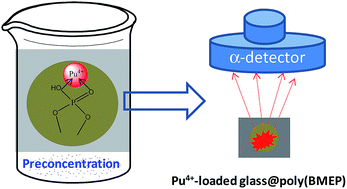Phosphate-bearing polymer grafted glass for plutonium(iv) ion-selective alpha spectrometry†
Abstract
A phosphate-bearing polymer thin film was covalently anchored on a glass substrate for alpha spectrometric determination of Pu4+ ions in aqueous samples. This method combined matrix elimination, preconcentration and source preparation into one-step sample manipulation. The thin polymer film was formed by first coupling 3-(trimethoxysilyl)propyl acrylate (TMSPA) on a hydrolyzed glass substrate by a sol–gel process, and simultaneously utilizing the double bonds of TMSPA for the UV-initiator-induced graft polymerization of bis[2-(methacryloyloxy)ethyl] phosphate monomers. The thin phosphate ligand bearing the thus formed poly(bis[2-(methacryloyloxy)ethyl] phosphate) (poly(BMEP)) film was characterized for homogeneity, physical morphology, and its affinity toward representative actinide ions such as UO22+, Am3+, Th4+ and Pu4+ in a HNO3 medium. Alpha track radiography and elemental mapping of the C and P atoms indicated uniform formation of the poly(BMEP) film on the glass substrate. Atomic force microscopy indicated a 10–15 nm thickness of the film, and the alpha spectrum of Pu4+-loaded glass@poly(BMEP) exhibited well defined alpha energy peaks without any significant loss of energy in the host matrix. The glass@poly(BMEP) film was found to sorb Pu4+ ions preferentially in 3 mol L−1 HNO3 in the presence of competing UO22+ and Th4+ ions. Am3+ ions did not sorb to a significant extent under similar conditions, even in the absence of Pu4+ ions. The Pu4+ ions loaded on the glass@poly(BMEP) substrate were quantified by isotope-dilution alpha spectrometry. This glass@poly(BMEP)-based alpha spectrometric method was applied successfully to quantify Pu in aqueous samples. The concentrations of Pu measured by this technique were reproducible within ±6% and required a minimum preconcentration of 2.95 Bq Pu activity in the glass@poly(BMEP) film. The measured Pu concentrations showed good agreement with those obtained by standard thermal ionization mass spectrometry.



 Please wait while we load your content...
Please wait while we load your content...